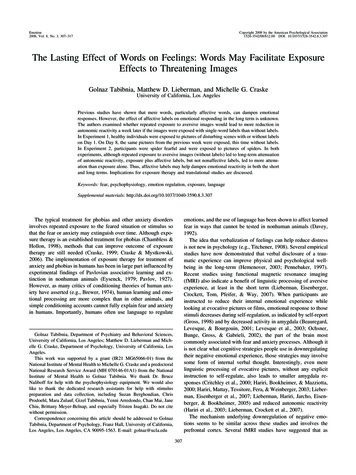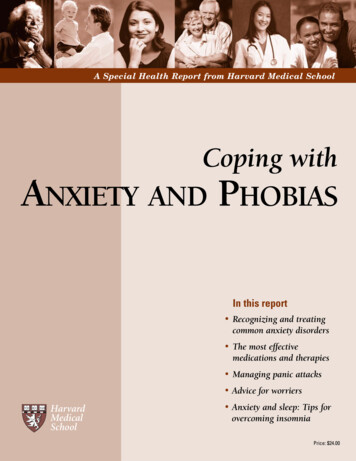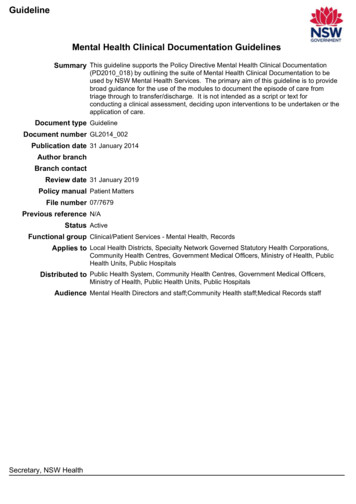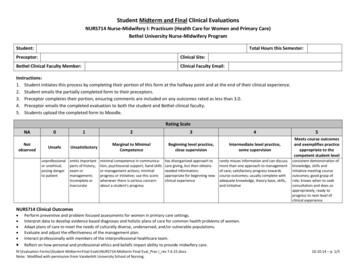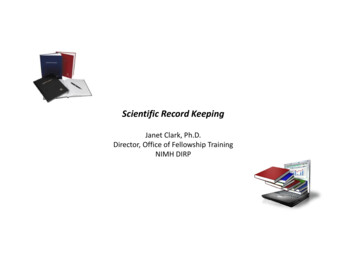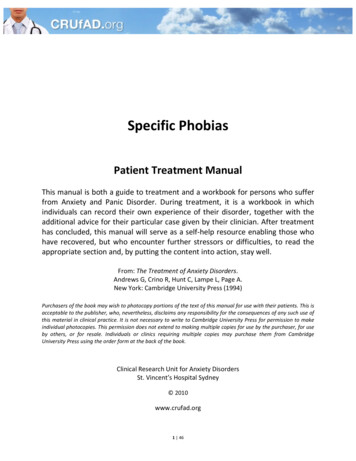
Transcription
Specific PhobiasPatient Treatment ManualThis manual is both a guide to treatment and a workbook for persons who sufferfrom Anxiety and Panic Disorder. During treatment, it is a workbook in whichindividuals can record their own experience of their disorder, together with theadditional advice for their particular case given by their clinician. After treatmenthas concluded, this manual will serve as a self‐help resource enabling those whohave recovered, but who encounter further stressors or difficulties, to read theappropriate section and, by putting the content into action, stay well.From: The Treatment of Anxiety Disorders.Andrews G, Crino R, Hunt C, Lampe L, Page A.New York: Cambridge University Press (1994)Purchasers of the book may wish to photocopy portions of the text of this manual for use with their patients. This isacceptable to the publisher, who, nevertheless, disclaims any responsibility for the consequences of any such use ofthis material in clinical practice. It is not necessary to write to Cambridge University Press for permission to makeindividual photocopies. This permission does not extend to making multiple copies for use by the purchaser, for useby others, or for resale. Individuals or clinics requiring multiple copies may purchase them from CambridgeUniversity Press using the order form at the back of the book.Clinical Research Unit for Anxiety DisordersSt. Vincent’s Hospital Sydney 2010www.crufad.org1 46
Section 11. The Nature Anxiety and PhobiasA phobia is a particular type of fear. Just as people fear many things, there is a large range ofthings that can become a phobic concern. However, a phobia is different from a fear for threereasons. The first of these is that the fear is intense and includes many of the followingsensations:BODILY SENSATIONS Heart racingSweatingTremblingRapid breathingBreathlessness or shortness of breathMuscular tension"Butterflies" in the stomachNauseaWeakness in musclesTingling in hands and feetHot and cold flushesChest tight or soreACTIONS Feeling like fleeing or doing soFeeling frozen to the spotCrying or screamingTHOUGHTS FearWorry "what if . . ."Embarrassed or irritatedShameConfused thinking"Something might happen""This is dangerous" or "I might act in a dangerous way"All of these actions, thoughts, and feelings are indications of fear and anxiety. It is important tonote that while they are unpleasant to experience, on their own they are not dangerous or lifethreatening. We will discuss later why these experiences occur, but before we do, the secondfeature of a phobia needs to be described.
Phobias involve avoidance of what is feared (or, at the very least, the object or situation isendured with distress). Because anxiety is unpleasant and people worry what might happen whenthey confront what they fear, people with phobias avoid the objects orsituations that make them afraid. This avoidance may take many different and subtle forms, suchas: Not going near the feared object or situationEscaping the situationMaking excuses for not doing what scares youImagining yourself somewhere elseThinking about something elseLooking the other wayDrinking alcohol or taking other drugsTaking antianxiety medicationsSeeking the presence of othersTalking to the people you are with about anythingMany of the ways in which people with phobias avoid what they fear are subtle and this, in part,may be due to the final important characteristic of a phobia, its "irrationality." As you may havefound, people who do not have phobias have difficulty understanding those who do; they maysay that the fears are silly, childish, and nonsensical. And while you also know that the situationdoes not represent a real danger, at another level you may believe that it may do so. You mayeven be able to agree with your family and friends and say that "I know that nothing willhappen" but it doesn't help. There is still this other part of you that is afraid a nagging doubtthat says "what if . . ."To summarize what we have covered so far, phobias are characterized by three things. First,there is an intense fear and anxiety about some object or situation. Second, there is an avoidanceof the feared object or it is endured with great difficulty. Finally, there is a conflict betweenthe knowledge that the situation is relatively safe and the belief that it may not be.1.1 Rationale the ProgramThe program will focus on the three aspects of the phobia and you will be given skills thatspecifically target each of them. As such, the treatment is like a tripod. It requires all three legs tobe present to stand firmly. This means that you will need to learn, practice, and keep using all ofthe techniques to control your anxiety. The three strategies that this program covers aretechniques designed (1) to control your physical sensations, (2) to help you face morecomfortably the things that you currently fear and avoid, and (3) to modify what you say toyourself. A further module will cover skills that have specific relevance to controllingthe fainting in the presence of blood and injury.It is important to realize that achieving control of anxiety is a skill that has to be learned. To beeffective, these skills must be practiced regularly. The more you put in, the more you will get outof the program. It is not the severity of your fear or avoidance, how long you have had yourphobia, or how old you are that predicts the success of the program. Rather, it is your motivationto change your reactions. Using all three techniques, you will be able to master your fear.
1.2 The Nature of AnxietyPeople who have suffered with a phobia often become afraid of even small amounts of anxiety.But anxiety is useful.Consider the following:A person is walking across a field that seems to be empty. Suddenly, a bull emerges, sees thewalker, bellows, and then charges. The walker realizes the danger and starts running for thefence some distance away. Automatically, changes occur in the body so that thewalker is able to run very quickly toward the fence.Your brain becomes aware of danger. Immediately, adrenaline is released to activatethe involuntary nervous system, which causes a set of bodily changes. Every change enables youto act quickly, avoid injury, and escape danger. By examining each of the changes in turn, theadvantages of this alarm response can be made clear. Breathing speeds up and the nostrils and lungs open wider, increasing the oxygenavailable for the muscles. Heart rate and blood pressure increase so that oxygen and nutrients required by the bodycan be transported quickly to where they are needed. Blood is diverted to muscles. Less blood goes to areas that do not immediately requirenutrition. Blood moves away from the face and you may "pale with fear." Muscles tense, preparing you to respond quickly. Blood-clotting ability increases so that blood loss will be minimized. Sweating increases to cool the body. The mind becomes focused. It becomes preoccupied with the thought, "What is thedanger and how can I get to safety?" Digestion is put on hold. Your mouth dries as less saliva is produced. Food sits heavily inthe stomach and nausea or "butterflies" may occur. Glucose is released to provide energy. The immune system slows down. In the short term, the body puts all of its efforts intoescape Sphincter muscles around the bowel and bladder constrict so that no trail is left by whicha predator could track you down.
It is the automatic activation of this flight or fight response that allows you to run and escape.The flight or fight response is an automatic reaction that will first lead you to flee from danger.Only when escape is impossible will you turn and fight for your life.In contrast to this life-saving alarm, it is clear that not all anxiety is of the same intensity. Theprospect of examinations or a job interview may increase anxiety but not usually to the samedegree as if one were faced with a vicious dog. However, whatever the degree of anxietyexperienced, it is controlled by the involuntary nervous system.The alarm is triggered, but to alesser degree.1.3.1 Anxiety: A False AlarmAnxiety problems originate when the flight or fight response is too sensitive. Like a too sensitivecar alarm that goes off at the wrong time, when the body's alarm is too sensitive, the flight orfight response is triggered at the wrong times. If your anxiety alarm goes off too easily, you willbe more likely to become anxious in situations where other people would not feel anxious. If youhave become anxious in situations in which other individuals would not be so anxious, itsuggests that your anxiety "alarm" (the flight or fight response) is too sensitive. The alarmreaction, designed to protect them from charging bulls and other physical dangers, was triggeredat the wrong time.The flight or fight response is useful in the short term, especially if the danger can be avoided byphysical exertion. But it is of no use in the long term and certainly of little use in most stressfulsituations in the modern world. It does not help to run when the traffic cop pulls you over and itdoesn't help to fight physically when you are threatened by the boss. However, because the flightor fight response was useful when we were cavemen and cavewomen, it is still part of our bodilymake up.1.3 Why Do Have False Alarms?If phobic fears are false alarms, because your flight or fight response is too sensitive, why hasthis happened? Psychological research has revealed three causes of a sensitive anxiety alarm.The first is stress, which we all know can increase anxiety. The second is overbreathing (orhyperventilation), and we will discuss this soon. The third reason for false alarms is yourpersonality.1.4 The Effect of PersonalityPersonality refers to the usual way we react, feel, and behave. Most people who seek treatmenthave come to regard themselves as nervous, not just because of their phobias but because theyconsider themselves to be people who are usually sensitive, emotional, and worry easily. Thereare advantages to being like this, for the sensitivity means you can understand other peoplequickly and hence are often liked in return. But the emotionality and the proneness to worry canbe the seeds from which a phobia can grow. The relaxation exercise that we will teach you willaid you to control this aspect of your personality. This type of personality makes it very easy foryou to lose your temper and make mistakes when trying to cope under stress.1.5 The Effect History and LearningOne thing that stands out about phobias is the limited number of objects and situations that are
feared when the total number of possible objects and situations is considered. Common phobiasinclude: Fear of the darkFear of heightsFear of animals (e.g., dogs, insects, and reptiles)Fear of enclosed spaces or being trappedFear of blood and injuryFear of waterIf you look over this list, one of the things that becomes obvious is that they are all sensibleobjects or situations to be wary of if one lived more as our predecessors did. For instance, thosepeople who had a healthy respect for the dark would not venture into potentially dangerouscaves, and so on. People who had these fears would be more likely to live to an age at which theycould pass on the genes to their children. Over many years, human beings would all acquire acertain degree of fearfulness of these potentially dangerous objects and situations. In fact,children as a rule develop fears of the dark, heights, enclosed spaces, and so on. These fears arecommon and occur at predictable ages. Thus, humans develop fears of potential dangers as partof growing up. It is such situations that adults appear to be able to learn to fear very rapidly.Obviously, there are some exceptions to this general rule. Some dangers have not been aroundlong enough for the effects to be passed across generations. It is about these things that parentsspend so much of their time and energy trying to teach us: "Don't put your hand into the powersocket," "Look before you cross the road," "Don't play with matches." Therefore, we learn to beafraid of some things because of what we have been taught. Interestingly, it has been noted thatpeople can acquire fears just by observing another person being afraid. This is interesting,because if you were to ask that person what they were afraid would happen, they would beunable to tell you. Perhaps this is why some people with phobias say they are afraid even thoughthey cannot express what it is they worry might happen, or that they worry about events that theyknow to be improbable.Thus, we pass through childhood with a host of fears and anxieties, some of which ariseautomatically and others from what we experience. But as children grow up they are taught bytheir parents not to be too scared of these things. As children's abilities to think for themselvesdevelop, they are able to judge if the situation is dangerous. Adults therefore encourage childrento approach nondangerous objects and situations that elicit fear so that they can learn toovercome the anxiety. Gradually, the automatic fear reactions come under control. This generalfearfulness is important because two pathways to the development of a phobia become clear. Thefirst of these occurs because as children we all acquire, fairly automatically, fears of a reallyquite sensible range of objects and situations. These childhood fears have a strongcorrespondence to adult phobias. The reason for this similarity probably occurs because we havebeen taught that some feared situations are not really dangerous. For example, going into thereptile house at the zoo, where there is no real danger, we learn not to be afraid as we remainthere until the anxiety has gone away. Obviously, the more opportunities and encouragement youhad as a child to be in the presence of what you feared (when it was safe), the more chance thefear would have to go away. Also, the more nervous a person you are in general, the more fear
you would have been likely to have and therefore it would have taken more frequent and longerexposure for the fear and anxiety to dissipate. If you had insufficient opportunities and learningas a child, the fear would be more likely to return as an adult.When you reached adolescence, an important change would have happened. Before early teens,we develop a capacity for hypothetical thought: We can think along the lines of "what if. ." Ifthe fear has not been properly overcome in childhood, then it is likely that you would start toworry, "What if the snake got out, then it might bite me," "What if I was to lose control of myselfand throw myself off the cliff." As a result, the fear would begin to gradually edge its way backin. Gradually, you would avoid the situations more and more as you imagined more and worsecatastrophes that would result.The second major pathway that phobias develop is as a result of something bad happening. If aperson was to walk down a dark alley and be bitten by a large dog, any sensible person wouldreact by being less than enthusiastic about venturing down the alley again. The amount of fearwill be related to how unpleasant the incident was.1.6 Role of HyperventilationHaving talked about why a phobia may have developed, we shall focus on one aspect of theflight or fight response of concern in phobias, namely, overbreathing (or hyperventilation).Hyperventilation causes many of the symptoms that occur in phobias. These symptoms areimportant among people with phobias, because some people fear the occurrence of the anxietyreaction more than the danger in the feared situation.The body needs oxygen in order to survive. Whenever a person inhales, oxygen is taken into thelungs where it is picked up by the hemoglobin (the "oxygen-sticky" chemical in the blood). Thehaemoglobin carries the oxygen around the body where it is released for use by the body's cells.The cells use the oxygen in their energy reactions, subsequently producing a by-product ofcarbon dioxide that is, in turn, released back to the blood, transported to the lungs, and exhaled.Efficient control of the body's energy reactions depends on the maintenance of a specific balancebetween oxygen and carbon dioxide. This balance can be maintained through an appropriate rateand depth of breathing. Breathing "too much" will have the effect of decreasing the levels ofcarbon dioxide, while breathing "too little" will have the effect of increasing levels of carbondioxide.Hyperventilation is defined as a rate and depth of breathing that is too much for the body's needsat a particular point in time. Naturally, if the need for oxygen and the production of carbondioxide both increase (as during exercise), breathing should increase appropriately.Alternatively, if the need for oxygen and the production of carbon dioxide both decrease(as during relaxation), breathing should decrease.While most of the body's mechanisms are controlled by "automatic" chemical and physicalmeans (and breathing is no exception), breathing has an additional property of being able to beput under voluntary control. For example, it is quite easy for us to hold our breaths (e.g.,swimming under water) or speed up our breathing (e.g., blowing up a balloon). Therefore, a
number of "nonautomatic" factors (and these also include emotion, stress, or habit) can cause usto increase our breathing. These factors may be especially important in people who suffer from aphobia when they are in the presence of the feared object or situation, causing these people tobreathe too much.Interestingly, while most of us consider oxygen as the determining factor in our breathing, thebody actually uses carbon dioxide as its "marker" for appropriate breathing. The most importanteffect of hyperventilation, then, is to produce a marked drop in carbon dioxide. This, in turn,produces a drop in the acid content of the blood leading to what is known as alkaline blood. It isthese two effects a decrease in blood carbon dioxide content and an increase in alkalinity thatare responsible for most of the physical changes that occur during hyperventilation.One of the most important changes produced by hyperventilation is a constriction or narrowingof certain blood vessels around the body. In particular, blood going to the brain is somewhatdecreased. Coupled together with this tightening of blood vessels is the fact that the hemoglobinincreases its "stickiness" for oxygen. Thus, not only does less blood reach certain areas of thebody, but the oxygen carried by this blood is less likely to be released to the tissues.Paradoxically, then, while overbreathing means we are taking in more oxygen, we are actuallygetting less oxygen to certain areas of our brain and body.This effect results in two broad categories of symptoms:1. Some symptoms are produced by the slight reduction in oxygen to certain parts of the brain.These symptoms include: dizzinesslight-headednessconfusionblurred visionfeelings of unreality2. Some symptoms are produced by the slight reduction in oxygen to certain parts of the body.These symptoms include: increase in heartbeat to pump more blood aroundbreathlessnessnumbness and tingling in the extremitiescold, clammy handsstiffness in the musclesIt is important to remember that the reductions in oxygen are slight and totally harmless.Hyperventilation is also responsible for a number of overall effects:1. The act of overbreathing is hard, physical work. Hence, the individual may often feel hot,flushed, and sweaty.
2. Because it is hard work to overbreathe, prolonged periods will often result in tiredness andexhaustion.3. People who overbreathe often tend to breathe from their chest rather than their diaphragm.As the chest muscles are not made for breathing, they tend to become tired and tense. Thusthese people can experience symptoms of chest tightness or even severe chest pains.If overbreathing continues, a second stage of hyperventilation is reached. This producessymptoms such as: severe vertigodizziness and nauseaan inability to breathe freelya crushing sensation or sharp pains in the chesttemporary paralysis of muscles in different parts of the bodyactual momentary loss of consciousness ("blackouts")rising terror fears that something terrible is about to happen,for example, a heart attack, brain hemorrhage, or even death.The symptoms in the second stage of hyperventilation are produced by the body's automaticdefense reaction to decreasing levels of carbon dioxide. This defense reaction forcibly restrictsthe person's breathing, allowing carbon dioxide levels to return to normal.Probably the most important point to be made about hyperventilation is that it is not dangerous.Increased respiration is part of the flight or fight response and so is part of a natural biologicalresponse aimed at protecting the body from harm. Thus, it is an automatic reaction for the brainto immediately expect danger and for the individual to feel the urge to escape. In particular,remember that increased heart rate caused by anxiety alone will not damage your heart andpeople do not die of fright. Even though it can feel uncomfortable and sometimes veryunpleasant, severe anxiety alone does not harm you physically.It is these symptoms of hyperventilation that produce what are known as "panic attacks" and thatare common in people with phobias but can occur in the absence of any phobic trigger. Mildhyperventilation can also cause an individual to remain in a state of perpetual apprehension. Forexample, knowing that you have to do or go near what you fear, your breathing rate may increaseslightly and help raise your anticipatory anxiety.Hyperventilation is often not obvious to the observer, or even to the persons, themselves. It canbe very subtle. This is especially true if the individual has been slightly overbreathing over along period of time.In this case, there can be a marked drop in carbon dioxide but because thebody is able to compensate for this drop, symptoms may not be produced. However, becausecarbon dioxide levels are kept low, the body is less able to cope with further decreases and evena slight change of breathing (e.g., a sigh, yawn, or gasp) can be enough to trigger symptoms.1.7 Types of OverbreathingThere are at least three types of overbreathing that you should learn to recognize. The first twotend to be episodic and are probably more common among people with specific phobias. That is,they occur only during episodes of high anxiety, such as when you are exposed to what you fear.
The other is habitual. That is, it occurs most of the time and is essentially a bad breathing habitor style.1.7.1 Panting Rapid BreathingSuch breathing tends to occur during periods of acute anxiety or fear. This type of breathing willreduce carbon dioxide levels very quickly and produce a rapid increase in anxiety.1.7.2 Sighing, Yawning and GaspingSighing and yawning tend to occur during periods of disappointment or depression and bothinvolve excessively deep breathing. Gasping occurs when people think of frightening things suchas doing something that they have avoided for a long time.1.7.3 Chronic Habitual OverbreathingThis type of breathing involves slight increases in depth or speed of breathing sustained over along period. Generally, this happens during periods of worry. It is not enough to bring on a senseof panic, but leaves the person feeling apprehensive, dizzy, and unable to think clearly. If suchpeople are placed in the presence of what they fear and increase their breathing even by a little,this may trigger panic.The relationship between phobias and hyperventilation is summarized in the following diagram.TRIGGERSPhobic SituationCatastrophe-related thoughtsSituation previously associated with panicPerception of imminentor present threatInterpretations of sensations ascatastrophicApprehensionFlight or fightresponseHyperventilationBodily and/or mentalsensationsAttempts ed from Salkovskis, P.M. (1988) Hyperventilation and anxiety. Current Opinion inPsychiatry, 1, p. 78.
1.8 Common Myths About Anxiety SymptomsWhen fear is intense, people often worry about the possible consequences of extreme levels ofanxiety. They may worry that anxiety will escalate out of control or that some serious physical ormental problem may result. As a result, the sensations themselves become threatening and cantrigger the whole anxiety response again. This accounts for why many people with phobias fearbeing anxious as much as, and sometimes more than, the potential dangers in their fearedsituation. It is therefore important to review the common misinterpretations about anxiety thatsome people have.1.8.1 Going Crazyof stress will cause the disorder. A third important point is that people who becomeschizophrenic usually show some mild symptoms for most of their lives. Thus, if this has notbeen noticed in you, then the chances are that you will not become schizophrenic.1.8.2 Losing ControlSome people believe that they will lose control when anxious. Often, they mean that they willbecome totally paralyzed and not be able to move, or they will not know what they are doing andwill run around wildly, hurting people or yelling out obscenities and embarrassing themselves.From our discussion of the flight or fight, we can see where this feeling may come from. Duringthe anxiety response, the entire body is ready for action and there is often an overwhelmingdesire to get away from any potential danger. There has never been a recorded case of anybodydoing anything "wild," out of control, or against their wishes. Ironically, once you take action,you are able to think faster and more clearly; you are actually physically stronger and yourreflexes are quicker. Think of examples of parents dealing very well with very frighteningsituations because they are trying to save their children.1.8.3 Something May HappenMany people worry that anxiety will escalate to such heights that something may happen.Looking at the flight or fight response we can see where this concern may come from. Activationof the flight or fight response increases an individual's tendency to focus upon threateningsituations and anticipate possible dangers. Just as when you walk down a dark alleyyou are sensitive to possible dangers, when anxious at other times you will tend to look fordanger. It is important to note that this experience is part of the flight or fight response and isdesigned to protect you from harm. If you are safe, then this extra sensitivity is not necessary butwill occur all the same. Rather than worry, it is better to remember that just becauseyou are anxious, catastrophes are no more likely to occur than when you are calm.
Section 22. Control Hyperventilation2.1 Recognizing HyperventilationThe first step in preventing and controlling hyperventilation is to recognize how and when youoverbreathe.Try monitoring your breathing rate now. Count one breath in and out as 1, the next breath in andout as 2, and so on. It may be difficult at first, but don't try to change your breathing ratevoluntarily. Write the answer here . As part of treatment you will be required to monitor yourbreathing rate for one minute during various times of the day. The form at the end of this sectionshould be used for this purpose.Now consider the following: Do you breathe too quickly?The average person only needs to take 10 12 breaths per minute at rest. If your rate ofbreathing is greater than this, then you must reduce it. Do you breathe too deeply?Does your chest sometimes feel overexpanded? You should breathe from the abdomen andthrough the nose, consciously attempting to breathe in a smooth and light way. Do you breathe from your abdomen?Sit with your arms folded lightly across your tummy and while breathing naturally observeyour arms, chest, and shoulders. While all three will move, the main movement should be inyour tummy if you are breathing correctly from your diaphragm. Do you sigh or yawn more than others?Become aware of when you sigh or yawn and avoid taking deep breaths atthese times. Do you gasp or take in a deep breath when, for example, someone mentions what youfear?Taking one deep breath can trigger the hyperventilation cycle in many people. Do you breathe through your mouth?You are more likely to hyperventilate if you breathe through your mouth. Whenever younotice this, you should consciously revert to breathing through your nose.2.2 Slow-Breathing TechniqueTo be done at first signs of anxiety or panic.You must learn to recognize the first signs of overbreathing and immediately do the following: Stop what you are doing and sit down or lean against something.
Hold your breath and count to 10 (don't take a deep breath). When you get to 10, breathe out and say the word "relax" to yourself in a calm, soothingmanner. Breathe in and out slowly in a six-second cycle. Breathe in for three seconds and out forthree seconds. This will produce a breathing rate of 10 breaths per minute. Say the word"relax" to yourself every time you breathe out. At the end of each minute (after 10 breaths), hold your breath again for 10 seconds, andthen continue breathing in the six-second cycle. Continue breathing in this way until all the symptoms of overbreathing have gone.If you do these things as soon as you notice the first signs of overbreathing, the symptoms shouldsubside within a minute or two and you will not experience any panic attacks. The more youpractice, the better you will become at using it to bring your phobic fear under control.Remember, your goal should always be to stay calm and prevent the anxiety and fear fromdeveloping into panic. You need to identify the very first symptoms of hyperventilation, and themoment you experience any of these, use the above slow breathing techniques immediately.2.3 Daily Record Breathing RateInstructions:
1.2 The Nature of Anxiety People who have suffered with a phobia often become afraid of even small amounts of anxiety. But anxiety is useful. Consider the following: A person is walking across a field that seems to be empty. Suddenly, a bull emerges, sees the walker, bellows, and then charg
